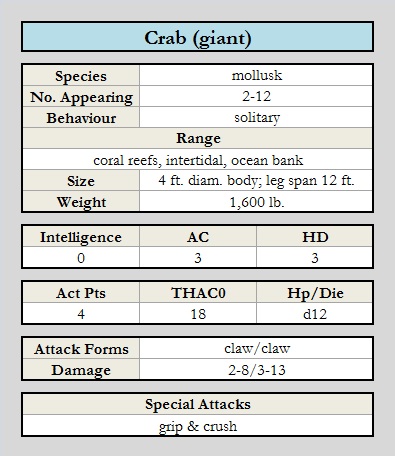Difference between revisions of "Crab (giant)"
(Import from old wiki. Image needed.) |
m (Removed categories) |
||
| Line 11: | Line 11: | ||
See [[Bestiary]]. | See [[Bestiary]]. | ||
| − | |||
| − | |||
Revision as of 19:33, 18 February 2020
These creatures are encountered near the sea, in most climates ranging from sub-arctic to tropical. They may be encountered up to two or three miles from the water, if the coastal lowland is sandy, soggy or rich with potential food sources. A giant crab's only interest is to feed; as they are primarily meat-eaters, they have been known to attack livestock and inhabitants if opportunity allows.
Giant crabs will move with a forward-sideways movement, usually forward and to the left, always edging around their prey as they attack. They use both their claws in attacking, with the larger claw weighing as much as 240 lbs. and the smaller about half as much. The larger claw is almost always used as a club; the smaller claw will pinch and grab.
If the giant crab succeeds in stunning an opponent with damage done by the small claw alone, this will indicate that the small claw has succeeded in gripping the victim. Once successful, the crab will begin to move away, retreating all the way to the water if necessary, until it is able to consume the victim; meanwhile, the crushed victim will suffer 1–-3 damage per round. The crab's claw is so powerful that nothing except the death of the crab will release the claw's grip.
The meat from a giant crab is edible and can, if preserved or transported to a market within 4 to 5 hours, be sold at a good price.
See Bestiary.
